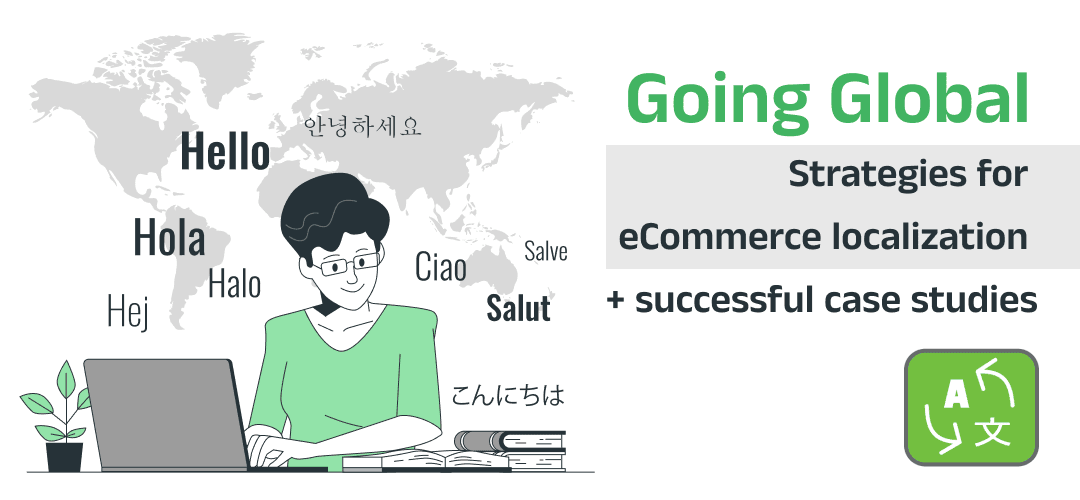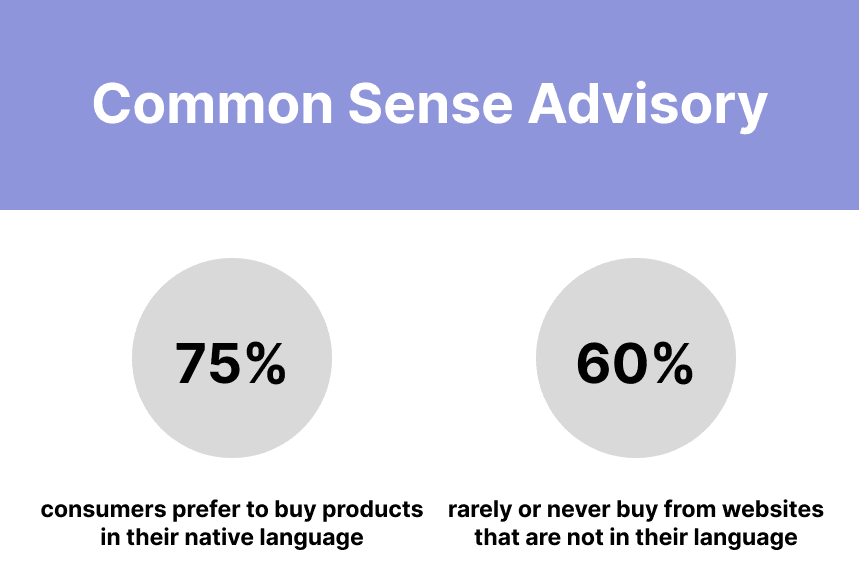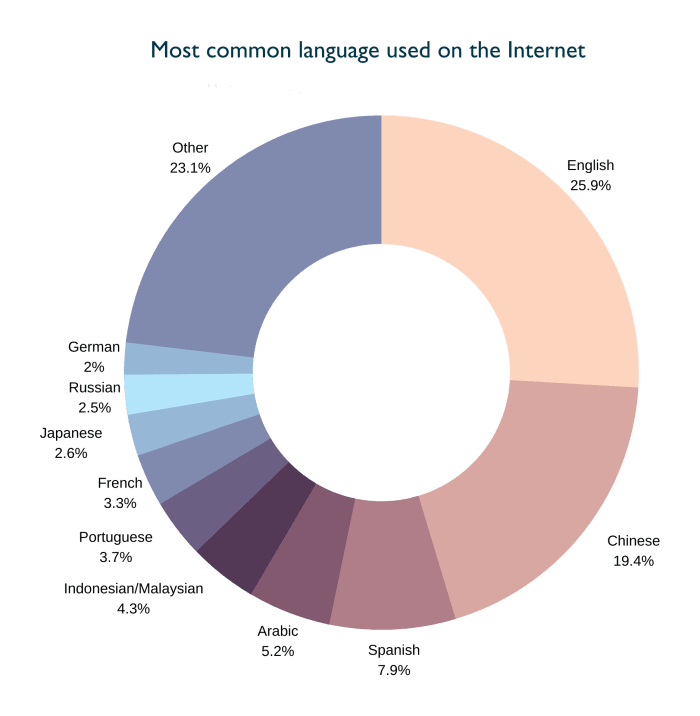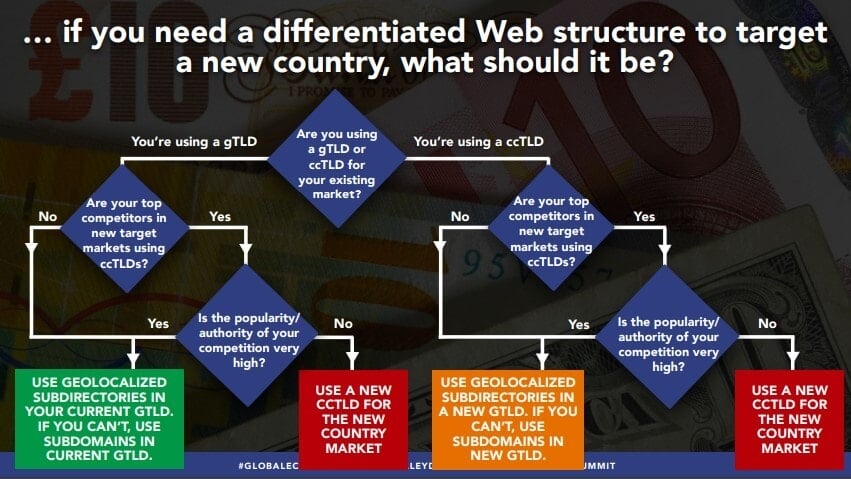
In today's globalized world, eCommerce has become a crucial part of any business strategy. With the increasing popularity of online shopping, businesses are expanding their reach beyond their home countries to tap into the massive potential of international markets.
However, simply translating your website or online store into different languages is not enough to ensure success in these markets. This is where eCommerce localization comes in.
This is the process of adapting your online store to meet the linguistic, cultural, and regulatory requirements of different target markets.
It includes translating content, adapting the layout and design to suit local preferences, and adjusting payment methods and shipping options to cater to local needs.

Furthermore, companies that invest in localization are 1.5 times more likely to experience revenue growth.
In this article, we’ll delve deeper into the concept of eCommerce localization and explore the benefits it offers to businesses looking to expand their reach globally.
Here you’ll find practical tips and strategies for implementing eCommerce localization, drawing on insights and statistics from leading industry sources, and show you how to succeed in the global marketplace.
Understanding eCommerce website localization
What’s the difference: eCommerce localization vs. translation
While eCommerce localization involves translation, it goes beyond simple language translation if you want to truly step into international eCommerce.
eCommerce website translation converts content from one language to another, without considering cultural nuances or local regulations. As a result, you can get a website that is not tailored to the needs and preferences of the target market, which can lead to lower engagement and sales.
On the other hand, localization takes a holistic approach, considering linguistic, cultural, and regulatory specifics. Good localization ensures that an online store is accessible to a wider audience, including non-native speakers and users with different cultural backgrounds.
The process involves translating product descriptions, images, and other content into a new language. To provide a seamless and personalized shopping experience for customers in different countries and regions, it’s also necessary to optimize design and functionality.
In addition, eCommerce localization may require adjusting prices, currencies, and payment methods, as well as shipping options and delivery times to meet local expectations and requirements.
Overall, eCommerce localization is a critical component of any business that seeks to expand its reach in the global marketplace. By adapting to the unique needs and preferences of local customers, businesses can improve customer engagement, drive sales, and build brand loyalty.
eCommerce website localization benefits
eCommerce localization is becoming increasingly essential for businesses that are looking to expand their reach globally.
In today’s globalized world, localization is no longer a luxury but a must-have for any enterprise that wants to succeed in the international marketplace. But why is localization important?
Instead of having a one-size-fits-all store, localizing your eCommerce website offers the following benefits to online retailers:
- Increased engagement. Localization can improve customer engagement by offering a more personalized and relevant shopping experience. This can lead to higher conversion rates, repeat purchases, and customer loyalty.
- Improved brand perception. When an online store is localized to suit the local culture, customers are more likely to perceive the brand as being trustworthy and reliable. This can help businesses build brand awareness and loyalty in new markets. For example, in Japan, it is common for websites to feature different designs and colors to appeal to local preferences.
- Expanded customer base. Customer experience localization can help businesses tap into new markets, including non-native speakers and users with different cultural backgrounds. By making an online store accessible to a wider audience, businesses can expand their customer base and increase revenue.
- More revenue. Recent studies have shown that companies that invest in eCommerce localization are 1.5 times more likely to experience revenue growth. By adapting an online store to meet the unique needs and preferences of local customers, businesses can drive sales and revenue growth in new markets. For example, Airbnb saw a 67% increase in bookings after it launched localized websites in 23 different languages.
- Better SEO. Localizing an online store can also improve its search engine optimization rankings in different countries and regions. The result is increased traffic and visibility, which can help businesses reach new customers and increase sales. Thus, Google rewards websites that have localized content with higher rankings in local search results.
As you can see, eCommerce localization is a critical component of any business strategy that seeks to expand its reach in the global marketplace.
But it doesn’t mean that you can get all these benefits at one go or with the same time and money effort. Keep on reading to learn more about the best localization practices and challenges that lie in wait.
5 steps to successful eCommerce localization
Although considered to be a gold mine, international localization of an eCommerce website is still a risky task. The desired market can be already pretty much taken by such giants as Amazon or eBay. And before heavily investing in local expansion, it’s better to make a proof shot.
When it comes to eCommerce localization, there are several best practices to keep in mind to ensure a successful global expansion. Below are some of the key aspects you should consider:
1. Do market & customer research
Before launching your eCommerce store in a new market, test the waters and monitor which country has the biggest appetite for your products. This includes assessing market demand, comprehending the competition, and adjusting marketing tactics to regional preferences.
First, use Google Analytics to segment on-site activity by place or region, and find potential growth points. Second, keep track of customers' requests about shipping. That way you can find a new country to include into your localization strategy.
Due to a lack of research, some of the most powerful brands failed to expand internationally. For example, Walmart ignored complex labor laws, constrained business hours and cultural nuances when entering the German market. In 2006, the company had to withdraw, incurring a $1 billion loss.
Let’s face it - some brands are simply not made for the global scale and can be successfully developed on the national market. And comprehensive research helps verify that the new region is worthwhile to invest your time and money.
2. Choose new languages wisely
Consider languages with a wide global reach to maximize your market potential. English, for example, has over 1.5 billion speakers but accounts for only 25% of Internet users. At the same time, Spanish, Mandarin Chinese and Arabic can be your bridge to millions of potential customers worldwide.
Assessing local demand is crucial for multilingual eCommerce strategies. If you're targeting the European market, languages such as German, French, Spanish, and Italian are worth considering due to their prevalence in the region.

Another important factor to consider is the availability of website localization tools and plugins for the languages you are considering. Look for robust localization solutions that streamline the translation and adaptation process, saving you time and resources.
Finally, keep an eye on your competitors’ strategies. Research successful cases within your industry to identify which languages offer a competitive advantage. By tailoring your website to the languages that your competitors may have overlooked, you can differentiate yourself and attract a niche market segment.
3. Localize currency, shipping and payment options
When expanding your ecommerce business into new markets, it's essential to localize currencies and offer region-specific payment options. This not only enhances the localized shopping experience but also instills trust and convenience for your customers.
Here are key considerations and strategies:
- Currency localization
- a. Currency conversion: Implement a currency conversion feature that allows users to view product prices and complete transactions in their local currency. This helps customers easily understand and compare prices, improving their shopping experience.
- b. Automatic currency detection: Incorporate automatic currency detection based on the user’s IP address or location. This feature dynamically adjusts the currency displayed, reducing friction and confusion for international customers.
- c. Exchange rates: Stay updated with current exchange rates and ensure accurate currency conversions. Display the rates prominently on your website or integrate with reliable currency exchange APIs to provide real-time and accurate conversion calculations, for example using an ECB exchange rate provider.
- Payment options
- a. Local payment gateways: Integrate popular and trusted local payment gateways that are widely used in the target market. Examples include Alipay in China, iDEAL in the Netherlands, or GiroPay in Germany. Offering familiar and preferred payment methods improves conversion rates and customer satisfaction. Note: An alternative to local gateways can be a global payment solution, like PayPal Commerce that accepts payment from 295 million PayPal accounts in 100 currencies around the globe.
- b. Mobile wallets: Consider integrating popular mobile wallet options such as Apple Pay, Google Pay, or local equivalents like WeChat Pay or Paytm. Mobile wallets are gaining popularity worldwide and provide a seamless and convenient payment experience for customers.
- c. Local bank transfers: In regions where bank transfers are commonly used for online payments, provide the necessary information for customers to make direct transfers. This includes bank account details, IBAN numbers, or specific payment references for easy transaction processing.
- Shipping methods
- a. Local carrier integration: Partner with local carriers in each target market to provide reliable and efficient shipping services. Collaborating with local carriers can help reduce shipping costs and significantly improve delivery times.
- b. Multiple shipping options: Offer a range of shipping options to cater to different customer needs. Include options for express shipping, standard shipping, and economy shipping, allowing customers to choose the option that best suits their requirements and budget.
- c. Real-time shipping calculations: Integrate shipping calculators that provide real-time shipping cost estimates based on the customer's location, package weight, and dimensions. This transparency enables customers to make informed decisions during the checkout process.
4. Adapt to local laws and regulations
When localizing your eCommerce website in new markets, it’s crucial to prioritize compliance with local laws and regulations.
Adhering to legal requirements not only ensures a smooth and trustworthy customer experience but also helps you avoid potential legal issues.
- Privacy and data protection
- a. Data protection laws: Familiarize yourself with local data protection regulations, such as the General Data Protection Regulation (GDPR) in the European Union or the California Consumer Privacy Act (CCPA) in the United States. Implement measures to safeguard customer data, including secure data storage, proper consent mechanisms, and clear privacy policies.
- b. Data transfer restrictions: Be aware of any restrictions on cross-border data transfers. Some countries impose limitations or require specific data transfer agreements. Ensure you have appropriate mechanisms in place, such as Standard Contractual Clauses (SCCs) or Binding Corporate Rules (BCRs), to facilitate compliant data transfers.
- Taxation and customs
- a. Tax compliance: Understand local tax obligations, including sales tax, value-added tax (VAT), or goods and services tax (GST). Comply with tax registration, collection, and reporting requirements in each target market.
- b. Customs declarations: Familiarize yourself with customs regulations and requirements for international shipments. Ensure accurate customs declarations and proper documentation to prevent delays or penalties.
- Intellectual property
- a. Trademark and copyright compliance: Respect local intellectual property laws and trademarks. Conduct thorough research to avoid infringing on existing trademarks or copyrighted materials when developing your brand name, logos, or product descriptions.
- b. Content licensing: Within your global content localization solution, if you use third-party content, such as images or videos, obtain proper licensing or permissions to avoid copyright violations. Localize content licenses to ensure compliance with regional copyright laws.
- Advertising and marketing
- a. Advertising regulations: Familiarize yourself with local advertising regulations, including restrictions on false or misleading claims, endorsement disclosures, and specific industry guidelines. Ensure your localized marketing campaigns comply with these regulations.
- b. Language and cultural sensitivity: Tailor your marketing messages and visuals to local customs and cultural sensitivities. Avoid any content that may be deemed offensive or inappropriate in the local market.
5. Optimize website for local search engines
The best way to localize a website is to implement effective SEO strategies. Optimizing your website for local search engines and targeting relevant keywords in the local language can significantly boost your online visibility and drive organic traffic.

- Technical considerations
- a. Country-specific domain or subdomain: Consider using a country-specific top-level domain (e.g., .de for Germany, .fr for France) or a subdomain (e.g., de.yourwebsite.com) to signal localization to search engines and users, and redirect international shoppers to their localized ecommerce store.
- b. Website localization markup: Implement sitemaps for each domain and hreflang tags to indicate language and regional targeting. This helps search engines understand your localized content and deliver it to the appropriate audience in search results.
- Localized content optimization
- a. Local language keywords: Conduct thorough keyword research in the local language of your target market. Understand how users search for products or services similar to yours and identify high-volume and relevant keywords. Use localized keyword research tools or enlist the help of native-speaking SEO experts to ensure accuracy.
- b. On-page SEO: Optimize your localized content by incorporating targeted keywords into titles, headings, meta descriptions, URLs, and image alt tags. Ensure that your website's structure and HTML markup follow best SEO practices and comply with local search engine guidelines. Regularly monitor and analyze your SEO performance using web analytics tools.
Following these simple steps, you can get your website prepared for international eCommerce, without overblowing localization costs or failing in the process. However, you can still face challenges on the road to achieve long-term success in new markets.
How to overcome most common eCommerce localization challenges?
Expanding your online business into new markets can be a game-changer, but it's not without its challenges. Understanding and addressing these challenges is crucial for a successful localization strategy.
- Language and cultural adaptation: Translating content accurately while capturing the nuances of the local language and culture can be challenging. It requires thorough research and the involvement of native speakers to ensure proper localization and avoid misunderstandings or cultural missteps.
- Technical implementation: Adapting the technical infrastructure of your eCommerce website to support localization can be complex. It involves integrating multilingual content management systems, currency conversion tools, localized payment gateways, and other technical aspects that require expertise and resources.
- Logistics and supply chain: Managing logistics and supply chain operations can be challenging when expanding into new markets. Dealing with international shipping, customs regulations, inventory management, and local distribution networks requires careful planning and coordination to ensure efficient operations.
- Customer support and communication: Providing efficient customer support in multiple languages and time zones can be demanding. Addressing customer inquiries, managing returns and exchanges, and handling localized customer service can require dedicated resources and effective communication systems.
- Maintaining consistency: Balancing global brand consistency with local customization is a challenge. Ensuring that the brand image and messaging remain cohesive across different markets while adapting to local preferences and cultural sensitivities can be a delicate balance.
- Localization ROI: Measuring the return on investment of eCommerce localization can be complex. Determining the impact of localized content on website traffic, conversions, and revenue requires proper tracking, analytics, and attribution models to assess the effectiveness of localization efforts.
By recognizing and addressing these challenges proactively, eCommerce businesses can overcome obstacles and maximize the benefits of localization. A strategic approach, careful planning, and leveraging the expertise of localization professionals can help navigate these challenges and drive success in international markets.
From translation to adaptation: localization strategy examples
When it comes to building and scaling a global eCommerce business, choosing the right platform is crucial. With its robust features, flexibility, and global reach, nopCommerce has emerged as an international eCommerce platform trusted by companies venturing into new markets.
What sets nopCommerce apart is its inherent focus on internationalization and localization. Designed with a global mindset, nopCommerce offers powerful features that cater to the needs of international businesses. It provides multi-language support, enabling the creation of localized storefronts to engage customers in their preferred language.
Moreover, it supports multiple currencies, making it easy to offer pricing in local currencies, thereby enhancing the customer experience and eliminating barriers to purchase.
In addition, nopCommerce excels in international shipping and taxation management. It seamlessly integrates with popular shipping carriers, enabling accurate shipping cost calculation, tracking, and delivery management.
It also facilitates compliance with local tax regulations, automating tax calculations based on customer location, saving time and ensuring accuracy.
To demonstrate the real-world impact of nopCommerce's international eCommerce capabilities, let's explore some case studies of businesses that have leveraged this platform to expand and thrive in global markets.
Dokkaner - localized online sales channel
The Dokkaner case study mentions a Saudi Arabian eCommerce website powered by nopCommerce and also having an English version. The website owner requested a complete redesign of the website’s UI/UX to more accurately reflect their brand value and product offerings, considering major differences in language structures.

Aside from design and UX, Dokkaner requested several functional customizations to better serve their business operations within the Saudi Arabian region such as support for QR code e-invoicing as mandated by the Saudi Zakat, Tax and Customs Authority (ZATCA).
xDalys - multi-language auto parts webshop
xDalys is the largest Lithuanian supplier of used auto parts, whose website is available in Lithuanian, English and Estonian. The company wanted to add more languages and localizations for their products, but faced performance issues after translation.

A new search plugin was developed to avoid any performance mistakes for the client’s database in numerous languages. Thanks to xDalys store upgrades and customization, the company was able to extend their catalog 14 mln products and build an SEO-friendly structure.
G7th - manufacturer website with a global reach
Through multifaceted localization, G7th managed to double the number of dealers selling the capos, increased the number of orders from a few per year to many per day, and built an overwhelmingly successful community.

The G7th eCommerce website success story includes pricing localization (shipping options for EU and non-EU countries and different VAT calculation) for online shopping and offline distributor map, showing where to buy their products worldwide.
By harnessing the power of nopCommerce, businesses can unlock their global potential, reach new audiences, and deliver exceptional localized shopping experiences.
Whether you are a growing startup or an established enterprise, nopCommerce provides the tools and support needed to conquer international markets and drive ecommerce success on a global scale.
Conclusion: how to unlock the global market?
In today’s interconnected world, site localization for eCommerce has become a necessity for businesses seeking to expand their reach and tap into new markets. The importance of ecommerce localization cannot be overstated.
By speaking the language of your customers, both literally and figuratively, you build trust, enhance user experiences, and gain a competitive edge in the global marketplace.
With the right approach, you can unlock the vast potential of international markets and establish a global presence. Embrace eCommerce localization and embark on a journey that opens doors to endless possibilities in the international eCommerce landscape.